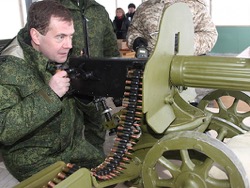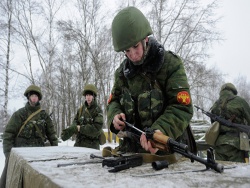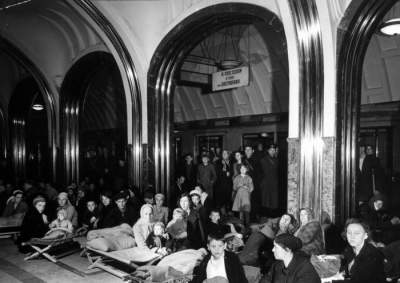
On the topic of the great Patriotic war there are many myths aimed against Russia, “corpses piled” up to “two million raped German women”. One of them is the superiority of German weapons over the Soviet. It is important that this myth applies including and without anti-Soviet (anti-Russian) motivation, “accidentally” – a typical example is the image of the Germans in movies. Often this is highly portrayed as the procession of the “blond beast” with rolled-up sleeves, which are poured from the hip the red army soldiers of “Schmeiser” (see below) long queues, and those only occasionally to snap a rare rifle shots. Cinematic! It happens even in Soviet films, and in today may reach up to one shovel for three sailing against the “tigers”.
Let’s compare the weapons that were in that time. However, this is a very broad topic, so let’s take for example small and in a narrow range, mass for enlisted personnel. That is, do not take pistols, machine guns, too (they would like, but the article has a limited volume). Also not considered specific, the type of nozzles krivostvolny Vorsatz J/Pz, and a specified narrow range, inspect it for mass market products, not specifically highlighting early model (SVT-38, SVT-40, MP-38, MP-40, for example). Sorry for the superficiality, but the details can always be found on the Internet, and now we need only a comparative overview of mass models.
To begin with, what the impression of many film “almost all Germans were, unlike soldiers, automatic weapons” is false.
In 1940, the German infantry divisions across the state had to be 12609 rifles and carbines, and only 312 submachine guns, ie less than the actual guns (425 110 manual and easel) and in the Soviet in 1941 – 10386 rifles and carbines (including sniper), machine pistols the same – 1623 PCs (and, incidentally, 392 light machine guns and heavy machine 166, and 9 heavy). In 1944, the same year the Germans on a division, there were 9420 carbines and rifles (including sniper), which accounted for 1595 submachine guns and assault rifles and the red army – 5357 rifles with carbines, submachine guns – 5557 pieces. (Sergei Melnikov, Standoff systems small arms of the Wehrmacht and the Soviet army, “Weapon” No. 4, 2000).
It is clearly seen that the state share of automatic weapons was in the red army even more in the beginning of the war, and over time, the relative number of submachine guns only increased. However, it is worth considering that “put on staff” and “had in fact” does not always coincide. Just at this time there was rearmament, and the new range of weapons just formed: “In June 1941 in the Kiev special military district small connection light machine guns had from 100 to 128% of the state, submachine guns, up to 35% of anti — aircraft guns- 5-6% of the state“. Also, we must remember that the biggest losses of weapons occurred at the beginning of the war, 1941.
It was in the Second world war the role of small arms has changed compared to the First: a long position of the “trench” of the confrontation has changed the operational maneuvering that has brought new demands for small arms. By the end of the war has clearly divided the specialization of weapons: long-range (rifles, machine guns) and for short distances with the use of automatic fire. And in the second case, first dealt with the fight at a distance up to 200 meters, but then came the understanding of the need to increase the sighting range automatic weapons up to 400-600 m.
But let’s move on to the specifics. Let’s start with German weapons.
First and foremost, of course, remember the carbine Mauser 98K.
 Photo: http://www.techcult.ru
Photo: http://www.techcult.ru
Caliber 7.92×57 mm, manual reload, the magazine of 5 rounds sighting range – up to 2000 m, so it is widely used with optical sights. The design was very successful, and after the war “Mauser” became a popular base for hunting and sporting weapons. Although the carbine is a remake of the rifle the end of the previous century, massively the Wehrmacht began to arm themselves with these rifles only since 1935.
The first automatic self-loading rifle in the infantry of the Wehrmacht began to arrive only at the end of 1941, it was the Walther G. 41.
 Photo: http://www.techcult.ru
Photo: http://www.techcult.ru
Caliber 7.92×57 mm, gas operated automatic, 10-round magazine, effective range up to 1200 m. the Appearance of this weapon due to the high assessment of the Soviet SVT-38/40 and the AVS-36, which the G-41 is still inferior. Main disadvantages: poor balance (center of gravity greatly amused forward) and demands on the service, in wartime conditions difficult. In 1943 it was upgraded to G-43, and before that the Wehrmacht is often preferred to use a captured SVT-40 Soviet production. However, in the embodiment, the Gewehr 43 was an improvement in the use of new venting systems, just borrowed the rifle Tokarev.
The most famous appearance of the weapon is the “Schmeisser” characteristic shape. Which designer Schmeisser has nothing to do, Maschinenpistole MP-40 was developed by the Henry Folmer. The earlier versions of the MP-36 and -38 separately will not be considered, as mentioned.
 Photo: http://www.techcult.ru
Photo: http://www.techcult.ru
Caliber: 9×19 mm Parabellum, rate of fire: 400-500 rounds/min magazine: 32 of the cartridge, effective range: 150 m for group targets, for a single – generally 70 m, because MP-40 when firing vibrates. It is just a question of “cinematic vs realism”: if the Wehrmacht attacked “film-like”, it would be a shooting range for the armed “mosinkami” and “svetimi” soldiers of the red army: the enemy would be shot for 300-400 meters. Another significant drawback was the lack of housing of the barrel during its rapid heating, which often lead to burns when firing bursts. It should also be noted the unreliability of the shops. However, for close combat, especially urban, the MP-40 is a very good weapon.
Initially, the MP-40 was only in commanders, then began to issue drivers, tank crews and paratroopers. Cinematic mass never was: the entire war was released 1.2 million MP-40, just as the Wehrmacht was designed more than 21 million people, and in 1941 the army was only about 250 thousand MP-40.
Schmeisser in 1943 developed for the Wehrmacht Sturmgewehr StG-44 (originally Mr-43). Incidentally, it is worth noting the presence of the myth that Kalashnikov allegedly ripped off the StG-44, which arose because of some resemblance in ignorance of the devices of both products.
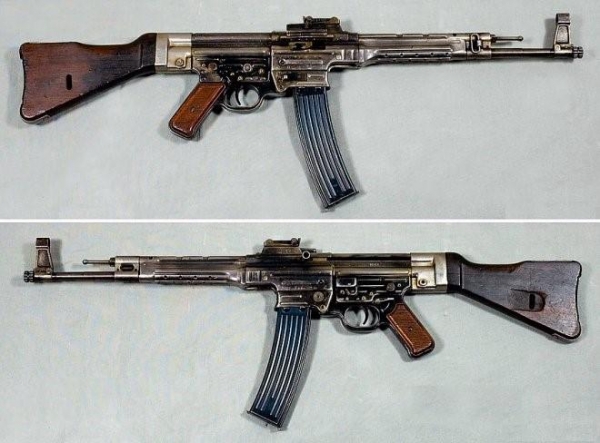 Photo: http://www.techcult.ru
Photo: http://www.techcult.ru
Caliber: 7.92×33 mm rate of fire: 400-500 rounds/min magazine: 30 rounds sighting range: up to 800 m. was provided the opportunity to mount a 30 mm grenade launcher and even the use of infrared sight (which, however, demanded knapsack battery itself was not compact). It’s a decent weapon for its time, but serial production was mastered in the fall of 1944 there were produced about 450 thousand of these assault rifles, which armed units of the SS and other elite units.
Go to the Soviet weaponry of the time.
Let’s start, naturally, with glorious rifle of Mosin 1891-30 sample gg, well and, of course, the rifle of the sample of 1938 and 1944.
 Photo: http://www.techcult.ru
Photo: http://www.techcult.ru
Caliber 7.62×54 mm reloading manual, a magazine of 5 rounds sighting range – up to 2000 m. the Basic weapon for infantry units of the red army of the first period of the war. Strength, reliability and easy maintenance became legends and folklore. Weaknesses include: a bayonet that is due to the outdated design had to be worn fixed to the rifle permanently, the horizontal arm of the shutter (this is really – why don’t you bend down?), the inconvenience of recharging and safety.
Soviet designer, gunsmith, F. V. Tokarev, developed a 10-shot self-loading rifle SVT-38in the late 30-ies, and then there was a modernized version of the SVT-40, weight 600 g less, and after this base was created sniper rifle.
 Photo: http://www.techcult.ru
Photo: http://www.techcult.ru
Caliber 7.62×54 mm, gas operated automatic, 10-round magazine, effective range – 1000 m. you can Often find opinions on good rifle, but it is connected with universal conscription: for fighters “from the plow” Mosin’s rifle, of course, easier to operate. In addition, in wartime conditions often faced a shortage of lubricants, and could be used wrong. You should also indicate the poor quality of the ammunition supplied under the lend-lease act, which gave excessive carbon Deposit. However, it all comes down to the need to comply with the service regulations.
While SVT had more firepower at the expense of automation and twice as many rounds in the magazine than the SVD, so the preferences were different.
As above mentioned, the Germans prized trophy SVT and was even adopted as a “limited standard”.
As for automatic weapons, in the beginning of the war the troops had a number of SMGS V. A. Degtyarev PPD-34/38, developed in the 30-ies of the Caliber 7,62×25 mm rate of fire: 800 rounds/min, store at 71 cartridge (drum) or 25 (carob), effective range: 200 meters. Used mainly by the border units of the NKVD, as, unfortunately, combined arms command thought more in terms of the First world war and did not understand the importance of the submachine guns. In 1940, PPD was structurally upgraded, but is still unsuitable for mass production in time of war, and by the end of 1941 was replaced by the weapons cheaper and more effective submachine gun Shpagina PPSH-41, also widely known thanks to the cinema.
 Photo: http://www.techcult.ru
Photo: http://www.techcult.ru
Caliber 7,62×25 mm rate of fire: 900 RDS/min effective range: 200 meters (sighting – 300, which is important for single shooting). PCA has inherited a drum magazine for 71 rounds, and later received more robust with a globe in 35 rounds. The design was based on stamping-welded technology that allowed to produce the product EN masse, even in the harsh conditions of war, and all the years of the war there were about 5.5 million PCA. Main advantages: best in class efficiency and range, ease and cheapness of manufacture. The disadvantages are the considerable weight and also too big rate of fire that leads to a waste of ammunition.
You should also remember invented in 1942 by Alex Agaevym PPS-42 (then PPS-43).
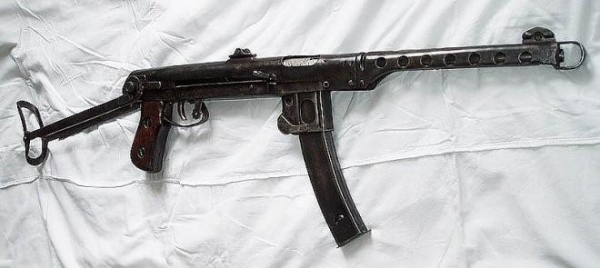 Photo: http://www.techcult.ru
Photo: http://www.techcult.ru
Caliber: 7,62×25 mm rate of fire: 700 RDS/min magazine: 35 rounds effective range: 200 meters. The bullet retains the stopping power of up to 800 m. Although the PPP was very high-tech in manufacturing (stamped parts are assembled by welding and rivets; materialsafety twice, and the labor costs three times less than in the PCA), it never became mass weapons, although for the remaining years of the war it produced about half a million copies. After the war, faculty were massively exported and copied abroad (the Finns made a replica of the M44 under 9 mm cartridge already in 1944), and then were gradually replaced in the army with a Kalashnikov assault rifle. Often PPS-43 is called the best submachine gun of world war II.
So, the myths about the “one rifle for three” is just Russophobic myths.
Some will ask: why, if everything was so good, blitzkrieg nearly succeeded?
First, do not forget that in 1941, just re going, and providing automatic weapons on the new standards have not yet been carried out.
Secondly, small firearms in the great Patriotic war – not the main damaging factor, it it usually losses are estimated at between a quarter and a third of the total.
Thirdly, there are areas where the Wehrmacht had at the beginning of the war a clear advantage: mechanization, transport and communications.
But the most important is the amount and concentration of forces, the accumulation of to the treacherous attack without Declaration of war. In June 1941 the Reich has concentrated for the attack on the USSR the direction of the Wehrmacht 2.8 million, and the total number of troops from the allies amounted to more than 4.3 million people. Thus in the Western districts of the red army numbered only about 3 million people, and it is in the districts near the borders was less than 40% of the personnel. Readiness, alas, was also not 100%, especially in terms of technology, we will not idealize the past.
Also we should not forget about the economy: while the Soviet Union was forced to hastily evacuate the factories to the Urals, the Reich in full used the resources of Europe, which is happy to lay under the Germans. Czechoslovakia, for example, before the war, was the leader of weapons production in Europe, and at the beginning of the war, every third German tank which was produced by concern “Skoda”.
During the great Patriotic war the Soviet Union fought and defeated not only Hitler, but practically the combined power of Europe – this should not be forgotten.
And the glorious tradition of designers-gunsmiths continue in our time, including in the area of small arms.

